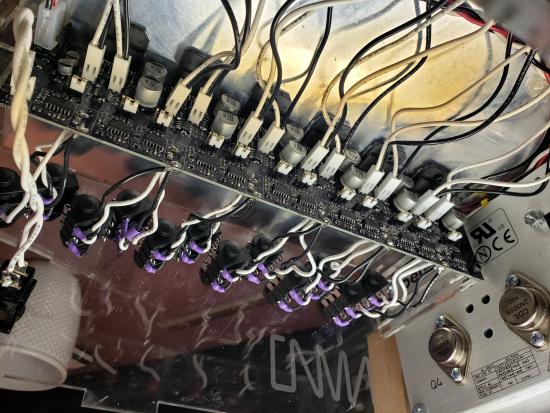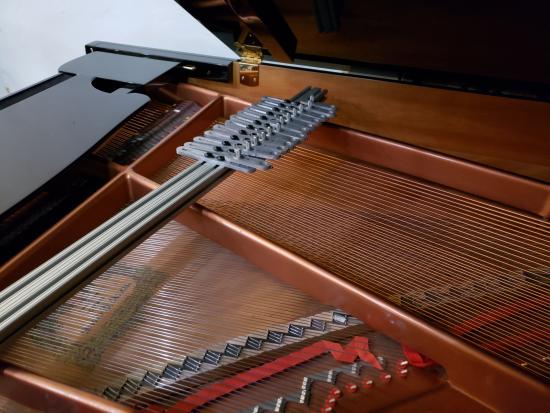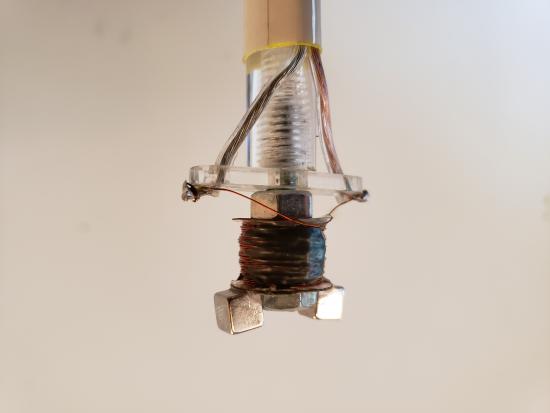Magnetic Resonator Piano
In Spring 2019 Jeremy Wagner set out to build a piano resonating device for upcoming research projects and performances by CNMAT composers. This work draws heavily on prior design work by Per Bloland, et al. with some improvements specific to upcoming CNMAT projects. The design brief called for a device meeting the following criteria:
- resonate piano strings (and any similarly magnetic object) across a wide range of frequencies and dynamics utilizing a magnetic field modulated by an audio signal
- the device should be modular, expandable, and precisely adjustable without interfering with the normal operation of the piano
- The device should be robust and reliable, easily transported, and quickly & easily installed on various types of pianos
- to the extents possible, the device should be constructed with readily available and easily sourced materials.
Our version of the magnetic resonator piano meets all of these design aims and was debuted in the premiere of Edmund Campion’s Late Bloomer for piano (4-hands) and magnetic resonator as part of the Interpretations series at Roulette, Brooklyn, NY, May 2, 2019.
Jeremy Wagner designed and fabricated the device drawing heavily on the work of Per Bloland who has done pioneering work in this area. His website, http://magneticpiano.com, has been an invaluable resource in this project. We note departures from the original design in the following sections.
Theory:
The main design problem for magnetically resonating piano strings comes down to a bit of basic physics. From the relevant equation for a solenoid…
{}
…where B is the magnetic flux density, N is the number of turns in the coil, I is the current running through the coil, l is the length of the coil, µ0 is the permeability of free space, and µeff is the effective permeability of the core material. Wetherefore find that the magnetic field delivered into the string will be maximized by minimizing the length of our driving coil while maximizing, each, the number of turns of wire in that coil, the effective permeability of our core and the amount of current delivered into that coil. Each of these optimization criteria pose engineering problems and tradeoffs that have been taken into account in the construction of our resonating device.
Amplifier:



Since the magnetic force generated by any coil will be proportional to current, we needed an amplifier built to maximize current delivery. This requires a specialized type of amplifier known as a transconductance amplifier which generates a current proportional to a signal voltage. We used a 12-channel circuit designed by Andrew McPherson which for Bloland’s original magnetic resonator piano. In correspondence with McPherson, we identified some of the common failure modes of that circuit related to heat dissipation and power supply voltage, taking some care to ameliorate those concerns in our execution of the design.
McPherson reported that the original design, when operated near its voltage limits, was susceptible to damage from inductive kickback when multiple coils were switched off at the same time. Essentially, the kickback from the simultaneous shut-off of multiple coils could dump enough energy into the power rails to destroy some of the integrated circuits. As such, we sized our power supply for ±24V as opposed to ±32V to allow some safety factor such that all 12 coils can shut down simultaneously without damage to the amplifier. Using a smaller power supply had the added benefits of reducing the overall size of the enclosure and running the circuit at a lower voltage helped to slightly reduce heat generated by the circuit.
The second concern associated with this circuit is heat dissipation. The circuit is built around six LM1876 amplifier ICs. In our initial tests with a 2-channel version of this circuit we observed that even with a sizeable heat sink, the circuit could get alarmingly hot. Certain coil impedances resulted in the heatsink reaching nearly 80°C. As such, when scaling up to 12-channels, great care was taken in sizing the heatsink for fan-less operation at supply voltages up to ±32V and ambient temperatures of 50°C, plus safety factor. This required an enormous heatsink with a thermal resistance of around 0.30°C/W. Further considerations related to enclosure design led us to specify an even larger heatsink of 0.24°C/W, which comprises a block of aluminum fins 3” x 7” x 12”. The amplifier still gets warm to the touch, but not uncomfortably so.
An enclosure incorporating the circuit, power supply heatsink, TRS input jacks and banana plug outputs was designed, etched and laser cut from acrylic sheet at the Jacob’s Institute for Design innovation.
Coil design:
Optimizing the efficiency of the coils was a major concern in this project and remains the focus of ongoing research. As opposed to Bloland’s approach, which used off-the-shelf electromagnets as coils, we experimented with a wide range of coil designs. We alighted on a very simple and inexpensive design that balances the design parameters of current handling, turns density and length into a fairly compact and effective coil design. Our coils are made from simple, 1/4-20 shank bolts from the local hardware store. We found bolts with ½” shanks, which when fitted with two laser-cut acetate washers to render a coil form, could accept 800 turns (about 70 feet) of 30AWG magnet wire. This yields a coil of about 8 ohms resistance that performs exceptionally well through most of the range of the piano. These standard bolts are made from carbon steel, which, while not ideal as a core material, nonetheless performs quite well in carrying the excitation field. The mechanical properties of these bolts also proved convenient in fixturing: the flats of their caps made for convenient mounting points for our neodymium focusing magnets, which are superglued to the end of the bolt to form a Halbach array, and their threads allowed easy mounting in our suspension system. Each coil is threaded into a non-conducting, non-magnetic acrylic rod, and the entire assembly is held in place by our fixturing system.


Suspension System:
For the suspension system we wanted to build a framework that was rigid, modular and precisely adjustable that could also be quickly installed or removed with repeatable results. We arrived at a solution that mounts an aluminum t-slot extrusion to the ribs of the piano with the help of some switchable magnets. This fixture then accommodates mounting of the aluminum height adjusters that carry the coil carriage assemblies.



This fixture required some custom bracketry which we designed and fabricated using a water-jet cutter at the Jacob’s institute for Design Innovation.
Findings:
In its initial debut at Roulette, Brooklyn, NY on May 2, 2019, the device performed extraordinarily well. Campion’s piece, uses the device to alter the resonance at several points throughout a 20 minute piano work. As the piece ends, the pianists leave the sustain pedal depressed as a composed resonance emerges from their final chord. This resonance continues on for about 3 minutes, migrating through the entire range of the piano.
One of the surprises of this performance was the degree to which the device alters the tuning of the instrument. For the performance, the device was installed on a 9’ Steinway Model D. The piano had been tuned that morning just prior to rehearsals, but when the piano tuner arrived to do a touch-up prior to the concert, he was astonished by how far the piano had gone out of tune since that morning. I had noticed this effect in our testing in Berkeley. The magnetic attraction of the Halbach array magnets, coupled with the constant attraction of the coils when operated in “single-ended” mode, serves to provide a small but significant upward baseline deflection of the piano string. This corresponds to an increase in the overall tension applied to the string, sending the note sharp. For notes with multiple strings, the unevenness of the applied force results in the notes going out of tune with themselves. Our piano tuner made heroic efforts to retune the piano to correct for these changes, but also realized that when the device was removed at intermission, many of the notes would be out again once more. Thankfully, he was amused enough by the device that he stayed for the concert and graciously retuned the piano after the device was removed during intermission. Knowing this, we may do away with the neodymium magnets and try running the amplifier in standard “double-ended” mode. These changes may decrease the achievable volume, but could allow the instrument to better remain in tune.
Another result of the first performance was a notable discrepancy in the performance of coils on the bass strings. These strings are physically more massive than the treble strings and require more time and energy to get going. Custom coils will need to be designed and tested for these strings, possibly featuring multiple coils in series or parallel coils of various inductances.
Lastly, when considering scaling the device to the full piano range, it seems obvious that another means of individually addressing strings should be explored. Already, in this 12-channel version we are reaching the limits of available interfaces. For the concert, we used a MOTU 1248 to provide analog input to the amplifier. The 1248 was connected over AVB to a MOTU Ultralite AVB, allowing control of the device over some distance. However, this invites the notion it might be possible to incorporate an AVB endpoint directly into the amplifier housing, thereby providing a reliable single ethernet connection to the system that could be operated over a great distance.








